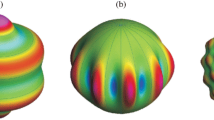Abstract
The development of studies on estimating the accuracy of the Earth’s modern global gravity models in terms of the spherical harmonics of the geopotential in the problematic regions of the world is discussed. The comparative analysis of the results of reconstructing quasi-geoid heights and gravity anomalies from the different models is carried out for two polar regions selected within a radius of 1000 km from the North and South poles. The analysis covers nine recently developed models, including six high-resolution models and three lower order models, including the Russian GAOP2012 model. It is shown that the modern models determine the quasi-geoid heights and gravity anomalies in the polar regions with errors of 5 to 10 to a few dozen cm and from 3 to 5 to a few dozen mGal, respectively, depending on the resolution. The accuracy of the models in the Arctic is several times higher than in the Antarctic. This is associated with the peculiarities of gravity anomalies in every particular region and with the fact that the polar part of the Antarctic has been comparatively less explored by the gravity methods than the polar Arctic.
Similar content being viewed by others
References
Bol’shakov, V.D. and Gaidaev, P.A., Teoriya matematicheskoi obrabotki geodezicheskikh nablyudenii (Theory of Mathematical Processing of Geodetic Observations), Moscow: Nedra, 1977.
Dem’yanov, G.V., Maiorov, A.N., and Pobedinskii, G.G., GLONASS and geodesy, Vestn. GLONASS, 2012, vol. 4, no. 1, pp. 48–53.
Global Gravity Field Models. International Centre for Global Earth Models (ICGEM). Cited 2017. http://icgem.gfz-potsdam.de/ICGEM/.
Kazakov, G.V. and Solov’ev, Yu.S., Basics of using the geodetic coordinate systems in planning the operation, preparation, and data control on launching the strategic missiles, in Nauchno-tekhnicheskii sbornik 29 NII MO RF (Scientific and Technical Transactions of 29th Research Institute of the Ministry of Defence of the Russian Federation), 2016, no. 26, pp. 91–93.
Key lines of development of the general-purpose geological and special works on regional exploration of the Earth’ interior in the Russian Federation land territories, continental shelf, Arctic and Antarctic. Approved by the Russian Federation Ministry of Natural Resources and Environment order 292 of December 26, 2006. http://docs.cntd.ru/document/902076387.
Koneshov, V.N., Nepoklonov, V.B., and Stolyarov, I.A., Study of the anomalous gravity field in the Arctic based on modern geopotential models, Izv., Phys. Solid Earth, 2012, vol. 48, nos. 7–8, pp. 587–593.
Koneshov, V.N., Nepoklonov, V.B., Sermyagin, R.A., and Lidovskaya, E.A., On the estimation of accuracy for global models of gravitational field of the Earth, Izv., Phys. Solid Earth, 2014, vol. 50, no. 1, pp. 127–136.
Koneshov, V.N., Nepoklonov, V.B., Pogorelov, V.V., et al., Arctic gravity exploration: state of the art and prospects, Izv., Phys. Solid Earth, 2016, vol. 52, no. 3, pp. 443–451.
Moritz, H., Advanced Physical Geodesy, Karlsruhe: Wichmann, 1980.
Nepoklonov, V.B., Computer models of anomalous gravity field of the Earth, Izv. Vyssh. Uchebn. Zaved., Geod. Aerofotos’emka, 1998, no. 6, pp. 104–106.
Nepoklonov, V.B., Methods for modeling the anomalous gravity field of the Earth, in Gravimetriya i geodeziya (Gravimetry and Geodesy), Moscow: Nauchnyi mir, 2010, pp. 379–382.
Pavlis, N.K., Factor, J.K., and Holmes, S.A., Terrain-related gravimetric quantities computed for the next EGM, Proc. 1st Int. Symposium of the International Gravity Field Service (Istanbul, 2006), Harita Dergisi, 2007, vol. 18, pp. 318–323.
Pavlis, N.K., Holmes, S.A., Kenyon, S.C., and Factor, J.K., The development and evaluation of the Earth Gravitational Model 2008 (EGM2008), J. Geophys. Res., 2012, vol. 117, no. B16, p. 4406.
Wessel, P., Smith, W.H.F., Scharroo, R., Luis, J., and Wobbe, F., Generic mapping tools: improved version released, EOS Transact. AGU, 2013, vol. 94, no. 45, pp. 409–410.
Author information
Authors and Affiliations
Corresponding author
Additional information
Original Russian Text © V.N. Koneshov, V.B. Nepoklonov, 2018, published in Fizika Zemli, 2018, No. 3.
Rights and permissions
About this article
Cite this article
Koneshov, V.N., Nepoklonov, V.B. Studying the Representation Accuracy of the Earth’s Gravity Field in the Polar Regions Based on the Global Geopotential Models. Izv., Phys. Solid Earth 54, 504–512 (2018). https://doi.org/10.1134/S1069351318030047
Received:
Published:
Issue Date:
DOI: https://doi.org/10.1134/S1069351318030047




